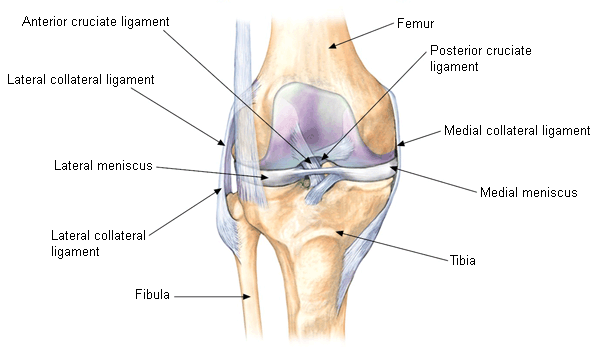Meniscal Tears
- Home
- Knee
- Common Ailments
- Meniscal Tears
Meniscal (cartilage) tears in the knee are very common in all genders and ages. Acute tears tend to occur with a twisting injury in people under the age of 65 where it is obvious that damage has occurred.
Degenerative tears occur in older people and happen over time with and without a specific injury. These tears may not produce many symptoms in some patients.

There are 2 menisci in each knee, which are ‘C’ shaped and made of fibrocartilage. The meniscus on the inside of the knee (medial meniscus) is larger than the one on the outside (lateral meniscus). It is torn more often because it is subject to larger forces and is tightly attached to other structures within the knee (the medial collateral ligament and the joint capsule). They have a poor blood supply and only the outer edge benefits from some circulation. This is why many torn cartilages are unable to heal.
The function of the menisci is to provide shock absorption and stability to the knee. They allow pressure to be spread evenly to help prevent excessive forces on the joint surfaces.

Acute meniscal tears usually occur when the knee is twisted and flexed (bent) in a weight baring position. It is common in sports like football, rugby, netball and tennis. It is also possible to have small tears without any symptoms that are then aggravated by an activity such as running or gym classes.
Degenerative tears occur as we age because the cartilage loses elasticity and is less able to cope with rapid and repetitive movement. There is a chance that people who participated in a lot of twisting sports or running when younger may be more prone to these type of tears.
- Sharp pain in the knee. The level of pains can vary between people and type of tear.
- Swelling.
- Locking. The patient is unable to bend or straighten the knee as the torn meniscus is stuck in the joint. This is usually extremely painful
- Clicking and clunking. This can occur as the flap of torn meniscus gets caught during movement but it is not always painful.
- Loss of movement. This can range from mild to severe and it is often straightening that is worse.
The application of ice is important in the early stages of an acute tear to help control swelling and provide pain relief.
Small tears and degenerative tears often settle and improve with physiotherapy. This involves a detailed examination to ensure there are no other structures injured. It is also important to identify any stiffness or loss of movement, which is not always noticed by the patient. This can increase the current symptoms but also contribute to problems longer term. Weak muscles, especially quadriceps (front of thigh), hamstrings (back of thigh) and gluteals (bottom muscles) can also prevent recovery and need specific exercises to regain strength without aggravating the healing joint. The physiotherapist may need to use techniques to stretch and mobilise knee to ensure full movement is regained.
Larger acute and degenerative tears require surgery if they do not settle or the pain worsens despite conservative treatment. This is done by arthroscopy where the surgeon can trim away the torn cartilage and tidy any frayed edges. In some cases it is possible to repair a tear using very small stitches. It is important to receive the correct physiotherapy after surgery as the rehabilitation protocol depends on the type of tear and operation performed.

